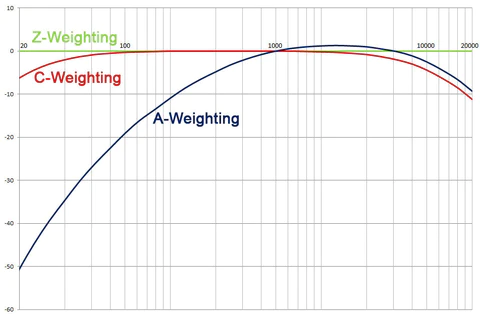A, C & Z Frequency Weightings Explained
-
 By
ATP Instrumentation
By
ATP Instrumentation
- 4 Nov 2022
- 0 Comments

Frequency weightings are one of the most important parameters you need to be aware of when measuring sound. Picking the one wrong one or failing to realise which one you are using can make you results invalid and unrepeatable. You may have noticed that most sound level meters offer a selection of frequency weightings to choose from, these are normally ‘A’, ‘C’ and occasionally ‘Z’. ‘B’ and ‘D’ also exist but these have fallen into disuse so won’t be covered here.
Sound frequency is the property of sound that determines pitch. You may already be aware that the human ear is more sensitive to some frequencies than others; it is actually most sensitive between 500 Hz and 6 kHz. When measuring sound, especially personal exposure to sound, it is important that the sound meter show us a realistic representation of what we actually hear. This is where Frequency Weightings come in. Frequency Weightings give more weight to different frequencies emphasising the sound received on certain frequencies and deemphasising others.
The 3 most commonly use weighting are A, C and Z. These standards are clearly defined in the sound level meter standards IEC 61672:2013 / BS EN 61672-1:2013.
| Frequency Weightings defined in IEC 61672:2013 | |||||||||
|---|---|---|---|---|---|---|---|---|---|
| Frequency (Hz) | 63 | 125 | 250 | 500 | 1k | 2k | 4k | 8k | 16k |
| A-weighting (dB) | – 26.2 | – 16.1 | – 8.6 | – 3.2 | 0 | + 1.2 | + 1.0 | -1.1 | – 6.6 |
| C-weighting (dB) | – 0.8 | – 0.2 | 0 | 0 | 0 | – 0.2 | – 0.8 | – 3.0 | – 8.5 |
| Z-weighting (dB) | 0 | 0 | 0 | 0 | 0 | 0 | 0 | 0 | 0 |
‘A’ Frequency Weighting
‘A’ Weighting is the most commonly used and covers the full frequency range of 20Hz all the way up to 20 kHz. It adjusts the readings to reflect the sensitivity of the human ear. At lower and higher frequencies the human ear is not very sensitive whilst being more sensitive between 500 Hz and 6 kHz. As you can see on the graph below (Fig.1), the curve shape is adjusted to roughly represent this range and offer a more realistic representation to the sound levels our ears are subjected too.
The ‘A’ weighting must be represented when used to ensure others know the parameter you used to record your results and can repeat them. As such, any recorded results are typically shown as dB(A) or dBA. Leq measurements would be displayed as LAeq etc.
‘C’ Frequency Weighting
Like ‘A’ Weighting, ‘C’ weighting follows the frequency sensitivity of the human ear but at much higher noise levels. This results in a much flatter curve giving much more emphasis to low frequency sounds. Peak measurements are normally taken using the ‘C’ Weighting.
‘C’ Weighting are represented by the letter C, dBC or dB(C). Lpeak would be displayed as LCPeak.
‘Z’ Frequency Weighting
‘Z’ Weighting is a flat frequency response between 10Hz and 20 kHz ±1.5dB. It is displayed as dBZ or dB(Z).







